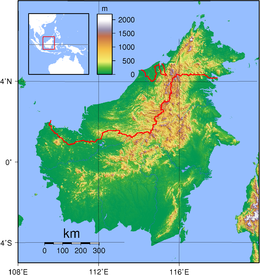History of Borneo

Topography of Borneo
|
|
| Geography | |
|---|---|
| Location | Southeast Asia |
| Coordinates | 01°N 114°E / 1°N 114°ECoordinates: 01°N 114°E / 1°N 114°E |
| Archipelago | Greater Sunda Islands |
| Area | 743,330 km2 (287,000 sq mi) |
| Area rank | 3rd |
| Highest elevation | 4,095 m (13,435 ft) |
| Highest point | Mount Kinabalu |
| Administration | |
| Districts |
Belait Brunei and Muara Temburong Tutong |
| Largest settlement | Bandar Seri Begawan (pop. ~50,000) |
| Provinces |
West Kalimantan Central Kalimantan South Kalimantan East Kalimantan North Kalimantan |
| Largest settlement | Samarinda (pop. 842,691) |
| States and FT |
Sabah Sarawak Labuan |
| Largest settlement | Kuching (pop. 617,886) |
| Demographics | |
| Population | 21,258,000 (2014) |
| Pop. density | 21.52 /km2 (55.74 /sq mi) |
| Ethnic groups | Bruneian Malay, Dayak, Iban, Kadazan-Dusun, Banjar, Sama-Bajau, Murut, Rungus and Lun Bawang/Lun Dayeh |
Borneo (/ˈbɔːrnioʊ/; Malay: Pulau Borneo, Indonesian: Kalimantan) is the third-largest island in the world and the largest in Asia. At the geographic centre of Maritime Southeast Asia, in relation to major Indonesian islands, it is located north of Java, west of Sulawesi, and east of Sumatra.
The island is politically divided among three countries: Malaysia and Brunei in the north, and Indonesia to the south. Approximately 73% of the island is Indonesian territory. In the north, the East Malaysian states of Sabah and Sarawak make up about 26% of the island. Additionally, the Malaysian federal territory of Labuan is situated on a small island just off the coast of Borneo. The sovereign state of Brunei, located on the north coast, comprises about 1% of Borneo's land area.
Antipodal to an area of Amazon rainforest, Borneo is itself home to one of the oldest rainforests in the world.
The island is known by many names. Internationally it is known as Borneo, after Brunei, derived from European contact with the kingdom in the 16th century during the Age of Exploration. The name Brunei possibly derives from the Sanskrit word "váruṇa" (वरुण), meaning either "water" or the mythological Varuna, the Hindu god of rain. Indonesian natives called it Kalimantan, which was derived from the Sanskrit word Kalamanthana, meaning "burning weather island" (to describe its hot and humid tropical weather).
...
Wikipedia
